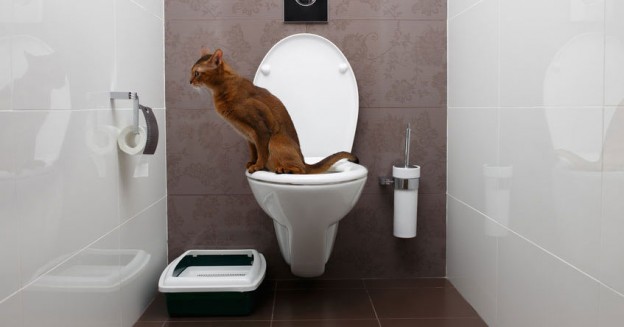Reasons Flushing Cat Poop Down Your Toilet Isn't a Good Idea - Advice for Proper Disposal
Reasons Flushing Cat Poop Down Your Toilet Isn't a Good Idea - Advice for Proper Disposal
Blog Article
The publisher is making a few great pointers relating to Can You Flush Cat Poop Down The Toilet? as a whole in this great article further down.

Introduction
As feline proprietors, it's vital to be mindful of just how we dispose of our feline close friends' waste. While it might seem convenient to purge cat poop down the bathroom, this technique can have damaging effects for both the atmosphere and human wellness.
Environmental Impact
Flushing feline poop presents dangerous pathogens and parasites into the water, presenting a substantial threat to aquatic ecological communities. These impurities can negatively influence aquatic life and compromise water high quality.
Health Risks
In addition to environmental worries, purging pet cat waste can also present wellness dangers to people. Cat feces may include Toxoplasma gondii, a bloodsucker that can trigger toxoplasmosis-- a possibly severe illness, particularly for expecting females and people with weakened immune systems.
Alternatives to Flushing
Fortunately, there are more secure and much more accountable ways to deal with pet cat poop. Think about the following alternatives:
1. Scoop and Dispose in Trash
The most usual technique of getting rid of pet cat poop is to scoop it into an eco-friendly bag and toss it in the trash. Make sure to use a dedicated trash inside story and throw away the waste quickly.
2. Usage Biodegradable Litter
Choose eco-friendly feline clutter made from materials such as corn or wheat. These litters are environmentally friendly and can be securely dealt with in the garbage.
3. Bury in the Yard
If you have a yard, consider burying feline waste in an assigned location away from vegetable gardens and water resources. Make certain to dig deep sufficient to avoid contamination of groundwater.
4. Set Up a Pet Waste Disposal System
Purchase a family pet waste disposal system particularly developed for feline waste. These systems make use of enzymes to break down the waste, minimizing odor and ecological effect.
Conclusion
Liable animal possession expands past offering food and shelter-- it likewise involves appropriate waste monitoring. By avoiding purging feline poop down the toilet and choosing different disposal methods, we can reduce our ecological impact and safeguard human wellness.
Why Can’t I Flush Cat Poop?
It Spreads a Parasite
Cats are frequently infected with a parasite called toxoplasma gondii. The parasite causes an infection called toxoplasmosis. It is usually harmless to cats. The parasite only uses cat poop as a host for its eggs. Otherwise, the cat’s immune system usually keeps the infection at low enough levels to maintain its own health. But it does not stop the develop of eggs. These eggs are tiny and surprisingly tough. They may survive for a year before they begin to grow. But that’s the problem.
Our wastewater system is not designed to deal with toxoplasmosis eggs. Instead, most eggs will flush from your toilet into sewers and wastewater management plants. After the sewage is treated for many other harmful things in it, it is typically released into local rivers, lakes, or oceans. Here, the toxoplasmosis eggs can find new hosts, including starfish, crabs, otters, and many other wildlife. For many, this is a significant risk to their health. Toxoplasmosis can also end up infecting water sources that are important for agriculture, which means our deer, pigs, and sheep can get infected too.
Is There Risk to Humans?
There can be a risk to human life from flushing cat poop down the toilet. If you do so, the parasites from your cat’s poop can end up in shellfish, game animals, or livestock. If this meat is then served raw or undercooked, the people who eat it can get sick.
In fact, according to the CDC, 40 million people in the United States are infected with toxoplasma gondii. They get it from exposure to infected seafood, or from some kind of cat poop contamination, like drinking from a stream that is contaminated or touching anything that has come into contact with cat poop. That includes just cleaning a cat litter box.
Most people who get infected with these parasites will not develop any symptoms. However, for pregnant women or for those with compromised immune systems, the parasite can cause severe health problems.
How to Handle Cat Poop
The best way to handle cat poop is actually to clean the box more often. The eggs that the parasite sheds will not become active until one to five days after the cat poops. That means that if you clean daily, you’re much less likely to come into direct contact with infectious eggs.
That said, always dispose of cat poop in the garbage and not down the toilet. Wash your hands before and after you clean the litter box, and bring the bag of poop right outside to your garbage bins.
https://trenchlesssolutionsusa.com/why-cant-i-flush-cat-poop/

I hope you enjoyed reading our part on How to Dispose of Cat Poop and Litter Without Plastic Bags. Thank you so much for finding the time to read our blog post. Do you know anybody else who is serious about the niche? Why not promote it. Thanks a lot for taking the time to read it.
Click Here Report this page